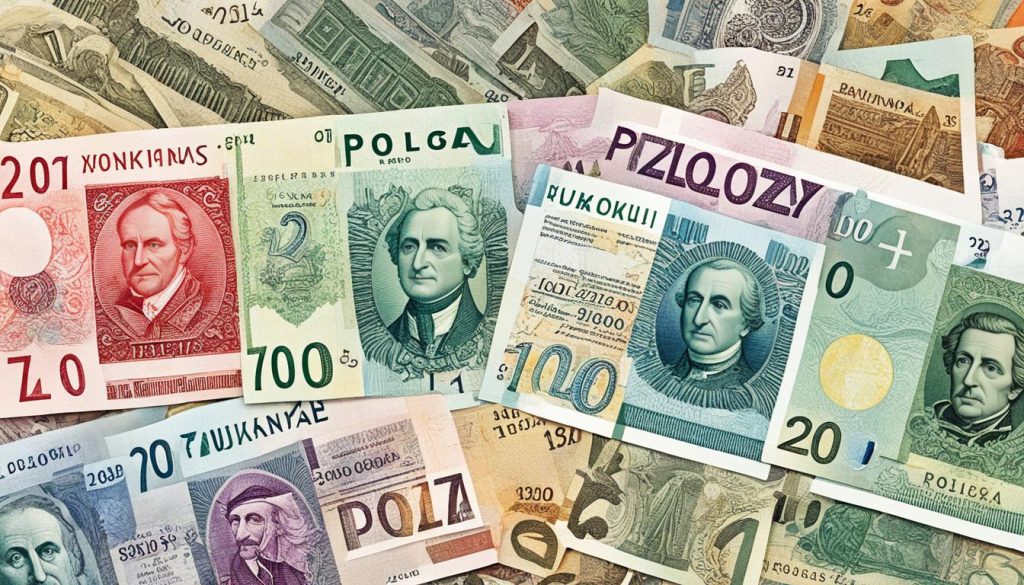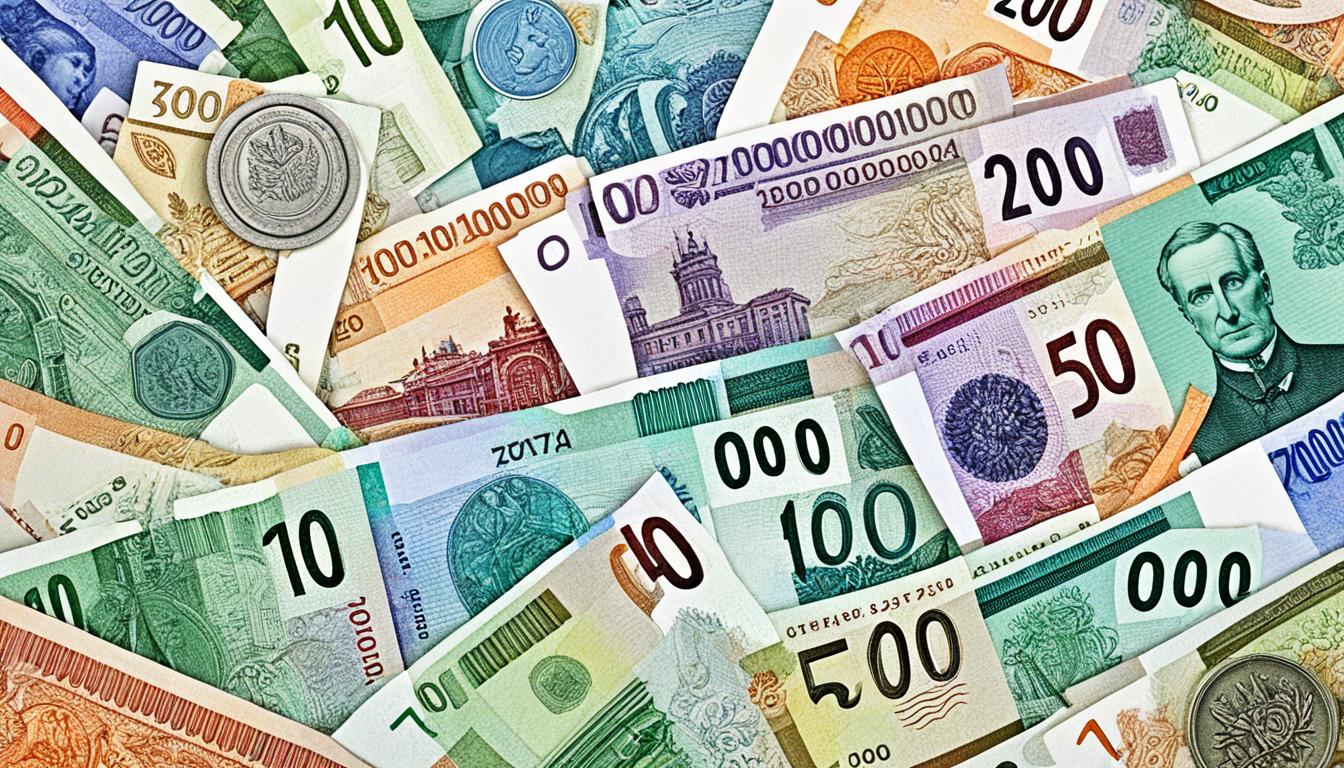The Polish Zloty (PLN) is at the heart of Poland’s economy. It’s not just money but also a sign of the country’s economic health. When we swap Polish currency, we get a glimpse into its economic world. This makes the PLN a key player internationally.
The Polish Zloty is crucial within Poland’s financial scene. It shows Poland’s financial independence and strength. Learning about the PLN means exploring how it supports daily life and investment in Poland.
To truly understand the PLN, we need to see how it ties into Poland’s economic story. This journey reflects the nation’s growth and future goals.
Key Takeaways
- The Polish Zloty (PLN), the cornerstone of the financial system in Poland, is critical in sculpting the nation’s economic identity.
- Understanding currency exchange in Poland is vital for comprehending the broader economic mechanisms at play.
- The Polish currency showcases the economic robustness and fiscal practices that set the stage for Poland’s financial discourse.
- The characteristics and utilisation of the PLN are imperative for both national and international economic engagements.
- With an authoritative stance in transactions, the PLN underpins the Polish economy’s capacity for stability and growth.
- The denominations of Polish currency not only facilitate trade but also reflect the country’s rich cultural heritage.
The History and Evolution of Currency in Poland
Exploring Polish monetary history shows a rich story of change. This reflects Poland’s economic and political ups and downs. The story of historical currencies of Poland tells of change and adaptation. It highlights Poland’s strength and clever solutions during hard times.
The journey from old coins to the current Polish Zloty history shows crucial changes over time. These changes mirror societal and technological advances. Initially, people traded goods directly. Then, minted coins started to help with trade and growth.

The Polish Zloty, starting in the Middle Ages, has changed a lot. Each version of the Zloty showed Poland’s status and economic condition. Changes in the Zloty’s value and new designs of coins and notes showed cultural trends. These steps led to today’s Zloty, created in the 20th century.
Through the 20th century’s challenges, the Zloty was significantly updated. These changes were part of efforts to make Poland’s financial system stronger and more stable.
Joining the European Union started talks about changing the currency again. But, the Polish Zloty still stands as a mark of national pride and a key part of Poland’s economy. Looking at currency changes in Poland, we see smart fiscal policy. We also see how important currency is in shaping a country’s identity.
- Early coinage and the introduction of the Polish Zloty
- Redenomination and the impact of world wars on currency stability
- Post-war economic reforms and the path to modern Zloty
- The influence of the European Union on Polish monetary policy
The story of Poland’s currency shows the country’s lasting strength and smart planning. As the world’s economy changes, the story of the Zloty continues. It is woven into Poland’s rich history and bright future.
Understanding the Polish Zloty: Poland’s Modern-Day Currency
The Polish Zloty is a symbol of Poland’s rich culture and strong economy. Its unique Polish Zloty features and PLN currency design showcase the nation’s heritage. Both banknotes and coins in Poland are carefully designed to reflect Polish history and symbols.
Every Polish Zloty note and coin showcases beautiful artwork. It features significant historical figures and national landmarks. The PLN currency design combines patterns and colors that echo Poland’s artistic and natural beauty. The Zloty is made with great care to ensure it is genuine and lasts a long time.
| Denomination | Artwork | Security Features |
|---|---|---|
| 10 PLN | Polish King Sigismund I | Watermark, Security thread |
| 20 PLN | King Bolesław I Chrobry | Holographic stripe, Microtext |
| 50 PLN | King Casimir III the Great | Colour-shifting ink, Raised printing |
| 100 PLN | King Władysław II Jagiełło | See-through window, Ultraviolet elements |
| 200 PLN | King Sigismund III Vasa | Latent image, Anti-copy watermark |
The security features of Polish currency stand out most. Every note includes advanced security elements like watermarks and holograms. These features are strong and blend well with the Zloty’s design, protecting it from being copied.
The banknotes and coins in Poland are regularly updated for better security and usability. They come in different sizes to help those with visual impairments. The tactile features improve handling for everyone. The Polish Zloty represents Polish independence and economic strength with its design and security.
In Poland’s lively markets and the precise financial dealings in banks, the Zloty is more than money. It symbolizes the country’s proud history and bright future.
Analyzing the Economic Impact of Currency in Poland
The Polish Zloty is vital for the country’s economy. It does more than facilitate buying and selling. It influences economic strength. We explore Poland’s currency role and its effect on growth. We also see how central bank policies in Poland aim to control inflation. This keeps the economy stable, touching everything from exchange rates to inflation.
The Role of the Zloty in Poland’s Economy
The Polish Zloty is crucial for Poland’s economic health. It helps keep the economy steady and encourages growth and unity. The Zloty allows for saving, investing, and spending, leading to prosperity.
A stable Polish Zloty builds trust with consumers and global markets. This stability means businesses can plan with fewer costs. It also attracts foreign investment to Poland. This investment brings jobs, technology, and international recognition to Polish industries.
Exchange Rates: Influence on Trade and Investment
The Polish Zloty’s exchange rate significantly affects international trade. It determines how competitive Poland’s exports are. Businesses must adapt to changes in the rate to stay competitive globally.
A good exchange rate can make Polish products cheaper abroad. This boosts exports and attracts foreign investors looking for value. Thus, the exchange rate is key for Poland’s economic appeal.
Poland’s Monetary Policy and Inflation Rates
Central to maintaining the Zloty’s value is Poland’s approach to inflation control. Poland’s central bank uses interest rate adjustments and policies to keep inflation predictable. These actions aim to keep prices stable.
Inflation impacts everyone’s living costs and Poland’s global position. The central bank monitors the economy to keep the Zloty stable. Their efforts help ensure Poland’s economic health and steady growth.
Conclusion
The summary of Poland’s currency offers deep insights into its financial system. The Polish Zloty is key to Poland’s economy. It shows a unique combination of stability and cultural identity.
Exploring the Polish Zloty helps us value its unique qualities and role in finance. Its design blends tradition and new technology. This showcases Polish pride and meets practical needs in the economy.
The future of Poland’s monetary system looks hopeful. Poland’s money managers are ready to face global changes. They will use smart policies and reforms. The Polish Zloty’s strength and adaptability will be essential as it faces new tests.
FAQ
What is the official currency of Poland?
Poland’s official currency is the Polish Zloty, internationally known as PLN.
Can you explain the financial system in Poland regarding its currency?
The Polish Zloty is essential in Poland’s economy. It is used to buy goods and services. It also affects currency exchange and international trade.
How can tourists perform currency exchange in Poland?
Visitors can swap their money for Polish Zloty at exchange offices, banks, and some hotels. You can also use ATMs and credit cards for getting cash and paying.
What distinguishes the Polish Zloty from other currencies?
The Zloty stands out because of its special features and designs. These show Poland’s culture and history, including national symbols and strong security details against fake notes.
How has Poland’s monetary history influenced its current currency?
The past changes and reforms in Poland’s money highlight its economic shifts. Moving to the modern Zloty reflects Poland’s growth and changes.
What are the key design features of the current Polish Zloty?
The Zloty shows Poland’s rich history and culture. It has pictures of famous people, events, and landmarks. It also includes high-level security like holograms and microprinting.
What role does the Polish Zloty play in Poland’s economy?
The Zloty is vital for Poland’s economy. It helps with trade, saving money, investing, and it supports the country’s financial policies. A stable currency keeps investors and the public confident.
How do PLN exchange rates affect international trade and investment in Poland?
PLN rates change how well Poland trades abroad. They also impact foreign investment. Changes in the Zloty’s value can boost or lower trade and investment.
What is Poland’s approach to inflation targeting and how does it affect the Zloty?
Poland’s bank fights inflation to keep the Zloty strong and ensure economic steadiness. Using interest rates and tools to manage inflation helps the Zloty stay stable.
What features of Polish currency reflect the nation’s identity?
The Zloty has images of Poland’s famous figures, places, and heroes. These images remind people of Poland’s history and identity daily.



